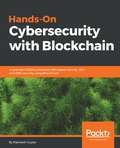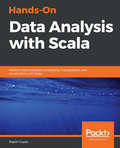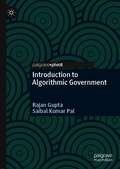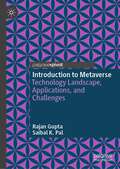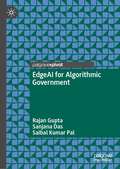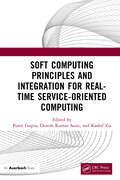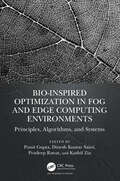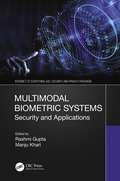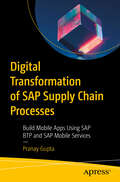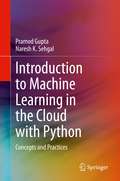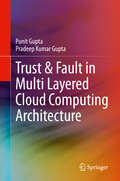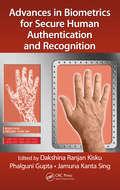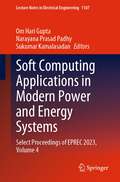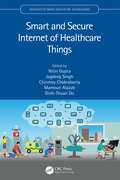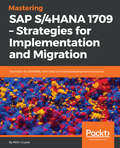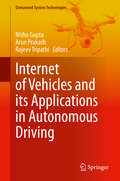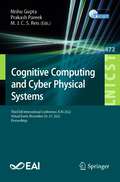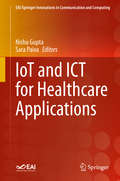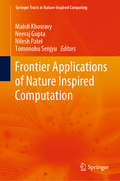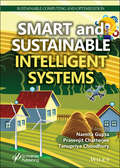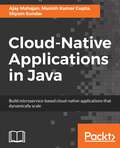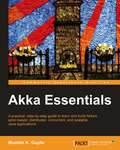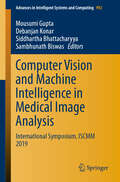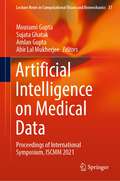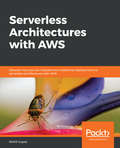- Table View
- List View
Hands-On Cybersecurity with Blockchain: Implement DDoS protection, PKI-based identity, 2FA, and DNS security using Blockchain
by Rajneesh GuptaDevelop blockchain application with step-by-step instructions, working example and helpful recommendationsKey Features● Understanding the blockchain technology from the cybersecurity perspective● Developing cyber security solutions with Ethereum blockchain technology● Understanding real-world deployment of blockchain based applicationsBook DescriptionBlockchain technology is being welcomed as one of the most revolutionary and impactful innovations of today. Blockchain technology was first identified in the world’s most popular digital currency, Bitcoin, but has now changed the outlook of several organizations and empowered them to use it even for storage and transfer of value.This book will start by introducing you to the common cyberthreat landscape and common attacks such as malware, phishing, insider threats, and DDoS. The next set of chapters will help you to understand the workings of Blockchain technology, Ethereum and Hyperledger architecture and how they fit into the cybersecurity ecosystem. These chapters will also help you to write your first distributed application on Ethereum Blockchain and the Hyperledger Fabric framework. Later, you will learn about the security triad and its adaptation with Blockchain. The last set of chapters will take you through the core concepts of cybersecurity, such as DDoS protection, PKI-based identity, 2FA, and DNS security. You will learn how Blockchain plays a crucial role in transforming cybersecurity solutions.Toward the end of the book, you will also encounter some real-world deployment examples of Blockchain in security cases, and also understand the short-term challenges and future of cybersecurity with Blockchain.What you will learn● Understand the cyberthreat landscape● Learn about Ethereum and Hyperledger Blockchain● Program Blockchain solutions● Build Blockchain-based apps for 2FA, and DDoS protection● Develop Blockchain-based PKI solutions and apps for storing DNS entries● Challenges and the future of cybersecurity and BlockchainWho this book is forThe book is targeted towards security professionals, or any stakeholder dealing with cybersecurity who wants to understand the next-level of securing infrastructure using Blockchain. Basic understanding of Blockchain can be an added advantage.
Hands-On Data Analysis with Scala: Perform data collection, processing, manipulation, and visualization with Scala
by Rajesh GuptaMaster scala's advanced techniques to solve real-world problems in data analysis and gain valuable insights from your dataKey FeaturesA beginner's guide for performing data analysis loaded with numerous rich, practical examplesAccess to popular Scala libraries such as Breeze, Saddle for efficient data manipulation and exploratory analysisDevelop applications in Scala for real-time analysis and machine learning in Apache SparkBook DescriptionEfficient business decisions with an accurate sense of business data helps in delivering better performance across products and services. This book helps you to leverage the popular Scala libraries and tools for performing core data analysis tasks with ease.The book begins with a quick overview of the building blocks of a standard data analysis process. You will learn to perform basic tasks like Extraction, Staging, Validation, Cleaning, and Shaping of datasets. You will later deep dive into the data exploration and visualization areas of the data analysis life cycle. You will make use of popular Scala libraries like Saddle, Breeze, Vegas, and PredictionIO for processing your datasets. You will learn statistical methods for deriving meaningful insights from data. You will also learn to create applications for Apache Spark 2.x on complex data analysis, in real-time. You will discover traditional machine learning techniques for doing data analysis. Furthermore, you will also be introduced to neural networks and deep learning from a data analysis standpoint.By the end of this book, you will be capable of handling large sets of structured and unstructured data, perform exploratory analysis, and building efficient Scala applications for discovering and delivering insightsWhat you will learnTechniques to determine the validity and confidence level of dataApply quartiles and n-tiles to datasets to see how data is distributed into many bucketsCreate data pipelines that combine multiple data lifecycle stepsUse built-in features to gain a deeper understanding of the dataApply Lasso regression analysis method to your dataCompare Apache Spark API with traditional Apache Spark data analysisWho this book is forIf you are a data scientist or a data analyst who wants to learn how to perform data analysis using Scala, this book is for you. All you need is knowledge of the basic fundamentals of Scala programming.
Introduction to Algorithmic Government
by Rajan Gupta Saibal Kumar PalThe world is changing at a fast pace, so is the Government and Governance style. Humans are bound to go for Algorithmic strategies rather than manual or electronic ones in different domains. This book introduces the Algorithmic Government or Government by Algorithm, which refers to authorizing machines in the Public Sector for automated decision-making based on Artificial Intelligence, Data Science, and other technologies. It is an emerging concept introduced globally and will be considered revolutionary in the future. The book covers concepts, applications, progress status, and potential use-cases of Algorithmic Government. This book serves as introductory material for the readers from technology, public policy, administration, and management fields.
Introduction to Metaverse: Technology Landscape, Applications, and Challenges
by Rajan Gupta Saibal K. PalThis book discusses Metaverse Technology, which is one of the emerging technologies around the world, through its concepts, definitions, architectural layers, economic implications, and presents comparison points with other allied areas like Web 3.0, Digital Twin, Blockchain, Multiverse, Artificial Intelligence, Internet of Everything and Hyperautomation.The book also presents several use-cases and adoption areas of Metaverse technology, along with global outlook of top companies implementing this technology through major platforms and tools. The potential use of this technology for Public Sector is also explored in this book, apart from the suggested business framework for its adoption. Potential misuse and ethical concerns have also been summarised. This introductory book on Metaverse, written with a multidisciplinary approach, will provide readers with a clear understanding of what the Metaverse is, what technologies are involved in its creation, and its current as well as potential future applications, in a very simple manner.
EdgeAI for Algorithmic Government
by Rajan Gupta Sanjana Das Saibal Kumar PalThe book provides various EdgeAI concepts related to its architecture, key performance indicators, and enabling technologies after introducing algorithmic government, large-scale decision-making, and computing issues in the cloud and fog. With advancements in technology, artificial intelligence has permeated our personal lives and the fields of economy, socio-culture, and politics. The integration of artificial intelligence (AI) into decision-making for public services is changing how governments operate worldwide. This book discusses how algorithms help the government in various ways, including virtual assistants for busy civil servants, automated public services, and algorithmic decision-making processes. In such cases, the implementation of algorithms will occur on a massive scale and possibly affect the lives of entire communities. The cloud-centric architecture of artificial intelligence brings out challenges of latency, overhead communication, and significant privacy risks. Due to the sheer volume of data generated by IoT devices, the data analysis must be performed at the forefront of the network. This introduces the need for edge computing in algorithmic government. EdgeAI, the confluence of edge computing and AI, is the primary focus of this book. It also discusses how one can incorporate these concepts in algorithmic government through conceptual framework and decision points. Finally, the research work emphasizes some design challenges in edge computing from applications viewpoint. This book will be helpful for data engineers, data scientists, cloud engineers, data management experts, public policymakers, administrators, research scholars and academicians.
Soft Computing Principles and Integration for Real-Time Service-Oriented Computing
by Punit Gupta Dinesh Kumar Saini Kashif ZiaIn recent years, soft computing techniques have emerged as a successful tool to understand and analyze the collective behavior of service- oriented computing software. Algorithms and mechanisms of self- organization of complex natural systems have been used to solve problems, particularly in complex systems, which are adaptive, ever- evolving, and distributed in nature across the globe. What fits more perfectly into this scenario other than the rapidly developing era of Fog, IoT, and Edge computing environment? Service- oriented computing can be enhanced with soft computing techniques embedded inside the Cloud, Fog, and IoT systems.Soft Computing Principles and Integration for Real-Time Service-Oriented Computing explores soft computing techniques that have wide application in interdisciplinary areas. These soft computing techniques provide an optimal solution to the optimization problem using single or multiple objectives.The book focuses on basic design principles and analysis of soft computing techniques. It discusses how soft computing techniques can be used to improve quality-of-service in serviceoriented architectures. The book also covers applications and integration of soft computing techniques with a service- oriented computing paradigm. Highlights of the book include: A general introduction to soft computing An extensive literature study of soft computing techniques and emerging trends Soft computing techniques based on the principles of artificial intelligence, fuzzy logic, and neural networks The implementation of SOC with a focus on service composition and orchestration, quality of service (QoS) considerations, security and privacy concerns, governance challenges, and the integration of legacy systems The applications of soft computing in adaptive service composition, intelligent service recommendation, fault detection and diagnosis, SLA management, and security Such principles underlying SOC as loose coupling, reusability, interoperability, and abstraction An IoT based framework for real time data collection and analysis using soft computing
Bio-Inspired Optimization in Fog and Edge Computing Environments: Principles, Algorithms, and Systems
by Punit Gupta Dinesh Kumar Saini Pradeep Singh Rawat Kashif ZiaA new era of complexity science is emerging, in which nature- and bio-inspired principles are being applied to provide solutions. At the same time, the complexity of systems is increasing due to such models like the Internet of Things (IoT) and fog computing. Will complexity science, applying the principles of nature, be able to tackle the challenges posed by highly complex networked systems? Bio-Inspired Optimization in Fog and Edge Computing: Principles, Algorithms, and Systems is an attempt to answer this question. It presents innovative, bio-inspired solutions for fog and edge computing and highlights the role of machine learning and informatics. Nature- or biological-inspired techniques are successful tools to understand and analyze a collective behavior. As this book demonstrates, algorithms, and mechanisms of self-organization of complex natural systems have been used to solve optimization problems, particularly in complex systems that are adaptive, ever-evolving, and distributed in nature. The chapters look at ways of enhancingto enhance the performance of fog networks in real-world applications using nature-based optimization techniques. They discuss challenges and provide solutions to the concerns of security, privacy, and power consumption in cloud data center nodes and fog computing networks. The book also examines how: The existing fog and edge architecture is used to provide solutions to future challenges. A geographical information system (GIS) can be used with fog computing to help users in an urban region access prime healthcare. An optimization framework helps in cloud resource management. Fog computing can improve the quality, quantity, long-term viability, and cost-effectiveness in agricultural production. Virtualization can support fog computing, increase resources to be allocated, and be applied to different network layers. The combination of fog computing and IoT or cloud computing can help healthcare workers predict and analyze diseases in patients.
Multimodal Biometric Systems: Security and Applications (Internet of Everything (IoE))
by Prof. Dr. Rashmi Gupta Dr Manju KhariMany governments around the world are calling for the use of biometric systems to provide crucial societal functions, consequently making it an urgent area for action. The current performance of some biometric systems in terms of their error rates, robustness, and system security may prove to be inadequate for large-scale applications to process millions of users at a high rate of throughput. This book focuses on fusion in biometric systems. It discusses the present level, the limitations, and proposed methods to improve performance. It describes the fundamental concepts, current research, and security-related issues. The book will present a computational perspective, identify challenges, and cover new problem-solving strategies, offering solved problems and case studies to help with reader comprehension and deep understanding. This book is written for researchers, practitioners, both undergraduate and post-graduate students, and those working in various engineering fields such as Systems Engineering, Computer Science, Information Technology, Electronics, and Communications.
Digital Transformation of SAP Supply Chain Processes: Build Mobile Apps Using SAP BTP and SAP Mobile Services
by Pranay GuptaTake a high-level tour of SAP oDATA integrations with frontend technologies like Angular using the SAP Mobile Services Platform. This book will give you a different perspective on executing SAP transactions on iOS using Angular instead of SAP-provided Fiori-based applications. You’ll start by learning about SAP supply chain processes such as Goods Receipt, Transfer Posting, Goods Issue, and Inventory Search. You’ll then move on to understanding the thought process involved in integrating SAP's backend (SAP ECC) with Angular iOS app using SAP Mobile Services running on SAP BTP. All this will serve as a guide tailored to SAP functional and technical consultants actively engaged in client-facing roles. You’ll follow a roadmap for modernizing and streamlining supply chain operations by leveraging Angular iOS apps. Digital Transformation of SAP Supply Chain Processes provides the essential tools for businesses looking to stay competitive in today's technology-driven landscape. What You Will Learn Study the fundamental procedures to set up the Authorization Endpoint, Token Endpoint, and base URL within SAP Mobile Services.Manage attachments in mobile applications and store them in an external content repository. Gain proficiency in testing OData services using the POSTMAN API client with OAuth protocol.Acquire knowledge about the JSON messages, CORS protocol, and X-CSRF token exchange.Link Zebra Printers through the Zebra Native Printing app on iOS App to print SAP forms on mobile printers. Who This Book Is For SAP Consultants with an interest in the Digital Transformation of SAP Supply Chain Processes to iOS-based SAP transactions.
Introduction to Machine Learning in the Cloud with Python: Concepts and Practices
by Pramod Gupta Naresh K. SehgalThis book provides an introduction to machine learning and cloud computing, both from a conceptual level, along with their usage with underlying infrastructure. The authors emphasize fundamentals and best practices for using AI and ML in a dynamic infrastructure with cloud computing and high security, preparing readers to select and make use of appropriate techniques. Important topics are demonstrated using real applications and case studies.
Trust & Fault in Multi Layered Cloud Computing Architecture
by Pradeep Kumar Gupta Punit GuptaThis book discusses various aspects of cloud computing, in which trust and fault-tolerance models are included in a multilayered, cloud architecture. The authors present a variety of trust and fault models used in the cloud, comparing them based on their functionality and the layer in the cloud to which they respond. Various methods are discussed that can improve the performance of cloud architectures, in terms of trust and fault-tolerance, while providing better performance and quality of service to user. The discussion also includes new algorithms that overcome drawbacks of existing methods, using a performance matrix for each functionality. This book provide readers with an overview of cloud computing and how trust and faults in cloud datacenters affects the performance and quality of service assured to the users. Discusses fundamental issues related to trust and fault-tolerance in Cloud Computing;Describes trust and fault management techniques in multi layered cloud architecture to improve security, reliability and performance of the system;Includes methods to enhance power efficiency and network efficiency, using trust and fault based resource allocation.
Advances in Biometrics for Secure Human Authentication and Recognition
by Phalguni Gupta Dakshina Ranjan Kisku Jamuna Kanta SingThis book showcases the technologies and algorithms being used for human authentication and recognition. Examining the full range of biometrics solutions, including unimodal and multimodal biometrics, the book covers conventional biometric techniques as well as novel systems developed over the past few years. It includes coverage of new biometric algorithms with novel feature extraction techniques, new computer vision approaches, soft computing approaches, and machine learning techniques under a unified framework used in biometrics systems. The text includes model question papers, mathematical notations, and exercises to reinforce understanding.
Soft Computing Applications in Modern Power and Energy Systems: Select Proceedings of EPREC 2023, Volume 4 (Lecture Notes in Electrical Engineering #1107)
by Om Hari Gupta Narayana Prasad Padhy Sukumar KamalasadanThis book includes select proceedings of EPREC 2023. It provides rigorous discussions, case studies, and recent developments in the areas of soft computing and its applications in power systems enabled with power electronics-based equipment, energy systems, and the energy community. The other topics to be covered are optimal planning, analysis, operation, and control related to modern power and energy systems, and applications of various soft computing methodologies. The readers find this book useful for enhancing their knowledge and skills in the domain areas.
Smart and Secure Internet of Healthcare Things (Advances in Smart Healthcare Technologies)
by Nitin Gupta Jagdeep Singh Chinmay Chakraborty Mamoun Alazab Dinh-Thuan DoInternet of Healthcare Things (IoHT) is an Internet of Things (IoT)-based solution that includes a network architecture which allows the connection between a patient and healthcare facilities. This book covers various research issues of smart and secure IoHT, aimed at providing solutions for remote healthcare monitoring using pertinent techniques. Applications of machine learning techniques and data analytics in IoHT, along with the latest communication and networking technologies and cloud computing, are also discussed. Features: Provides a detailed introduction to IoHT and its applications Reviews underlying sensor and hardware technologies Includes recent advances in the IoHT, such as remote healthcare monitoring and wearable devices Explores applications of data analytics/data mining in IoHT, including data management and data governance Focuses on regulatory and compliance issues in IoHT This book is intended for graduate students and researchers in Bioinformatics, Biomedical Engineering, Big Data and Analytics, Data Mining, and Information Management, IoT and Computer and Electrical Engineering.
Mastering SAP S/4HANA 1709 – Strategies for Implementation and Migration: Transition to S/4HANA with tried and tested deployment scenarios
by Nitin GuptaLearn every aspect of SAP S/4HANA and develop the skills needed to migrate from SAP ECCKey Features● Gain insight into the implementation and configuration of SAP S/4HANA ● Design business processes with SAP Central Finance● Learn the available SAP S/4HANA deployment options in depthBook DescriptionSAP S/4HANA implementation, migration, and Central Finance are the key projects being employed across the globe, with millions of consultants working day and night to implement them. Mastering SAP S/4HANA 1709 - Strategies for Implementation and Migration will allow you to gain a virtual implementation experience, and you can follow the steps to configure the learning system as per your requirements. This book focuses on several topics; each topic is covered in detail to make you a successful SAP S/4HANA professional.You will begin by understanding SAP HANA and then move toward S/4HANA and the deployment options available to customers, including what suits various customer needs. You will then understand the impact of S/4HANA on General Ledger, Asset Accounting, and Profitability Analysis; SAP notes will also be listed when needed. As you progress through the book, you explore premigration, migration, and post-migration steps including the Near Zero Downtime strategy and learn how to implement Central Finance with and without MDG using SLT. In the concluding chapters, greenfield implementations using SAP Activate methodology will also be covered.By the end of this book, you will have learned to successfully implement SAP S/4HANA projects that are customized for your business needs.What you will learnUnderstand SAP HANA and SAP S/4HANAImplement SAP S/4HANA as a greenfield implementation with SAP Activate methodologyDiscover the hidden challenges in SAP Central Finance Migrate from ECC to S/4HANA successfully in a non-disrupted roadmapExplore the change from Classic Asset Accounting to New Asset AccountingLearn to configure General Ledger, Profitability Analysis, and ControllingApply the Near Zero Downtime strategy to migration projectsWalk through Customer Vendor Integration (CVI)Who this book is forMastering SAP S/4HANA 1709: Strategies for Implementation and Migration is for project managers, solution architects, and consultants who are planning to implement SAP S/4HANA for ERP solutions and are in the process of implementing it or are currently upgrading/migrating to it.
Internet of Vehicles and its Applications in Autonomous Driving (Unmanned System Technologies)
by Nishu Gupta Arun Prakash Rajeev TripathiThis book provides an insight on the importance that Internet of Vehicles (IoV) solutions can have in taking care of vehicular safety through internetworking and automation. Key features of the book are the inclusion and elaboration of recent and emerging developments in various specializations of intelligent transportation systems and their solutions by incorporating IoT (Internet of Things) and IoV. This book presents to its readers useful IoV applications and architectures that cater to their improved driving requirements and lead towards autonomous driving. The application domains have a large range in which vehicular networking, communication technology, sensor devices, computing materials and devices, IoT communication, vehicular and on-road safety, data security and other topics are included.
Cognitive Computing and Cyber Physical Systems: Third EAI International Conference, IC4S 2022, Virtual Event, November 26-27, 2022, Proceedings (Lecture Notes of the Institute for Computer Sciences, Social Informatics and Telecommunications Engineering #472)
by Nishu Gupta Prakash Pareek M. J. C. S. ReisThis proceedings constitutes the post-conference proceedings of the 3rd EAI International Conference on Cognitive Computing and Cyber Physical Systems, IC4S 2022, held at Vishnu Institute of Technology, Bhimavaram in Andhra Pradesh, India, in November 26-27, 2022. The theme of IC4S 2022 was: cognitive computing approaches with data mining and machine learning techniques. The 22 full papers were carefully reviewed and selected from 88 submissions. The papers are clustered in thematical issues as follows: machine learning and its applications; cyber security and networking; image processing; IoT applications; smart city eco-system and communications.
IoT and ICT for Healthcare Applications (EAI/Springer Innovations in Communication and Computing)
by Nishu Gupta Sara PaivaThis book provides an insight on the importance that Internet of Things (IoT) and Information and Communication Technology (ICT) solutions can have in taking care of people's health. Key features of this book present the recent and emerging developments in various specializations in curing health problems and finding their solutions by incorporating IoT and ICT. This book presents useful IoT and ICT applications and architectures that cater to their improved healthcare requirements. Topics include in-home healthcare services based on the Internet-of-Things; RFID technology for IoT based personal healthcare; Real-time reporting and monitoring; Interfacing devices to IoT; Smart medical services; Embedded gateway configuration (EGC); Health monitoring infrastructure; and more.Features a number of practical solutions and applications of IoT and ICT on healthcare;Includes application domains such as communication technology and electronic materials and devices;Applies to researchers, academics, students, and practitioners around the world.
Frontier Applications of Nature Inspired Computation (Springer Tracts in Nature-Inspired Computing)
by Neeraj Gupta Tomonobu Senjyu Mahdi Khosravy Nilesh PatelThis book addresses the frontier advances in the theory and application of nature-inspired optimization techniques, including solving the quadratic assignment problem, prediction in nature-inspired dynamic optimization, the lion algorithm and its applications, optimizing the operation scheduling of microgrids, PID controllers for two-legged robots, optimizing crane operating times, planning electrical energy distribution systems, automatic design and evaluation of classification pipelines, and optimizing wind-energy power generation plants. The book also presents a variety of nature-inspired methods and illustrates methods of adapting these to said applications. Nature-inspired computation, developed by mimicking natural phenomena, makes a significant contribution toward the solution of non-convex optimization problems that normal mathematical optimizers fail to solve. As such, a wide range of nature-inspired computing approaches has been used in multidisciplinary engineering applications. Written by researchers and developers from a variety of fields, this book presents the latest findings, novel techniques and pioneering applications.
Smart and Sustainable Intelligent Systems (Sustainable Computing and Optimization)
by Namita Gupta Prasenjit Chatterjee Tanupriya ChoudhuryThe world is experiencing an unprecedented period of change and growth through all the electronic and technilogical developments and everyone on the planet has been impacted. What was once ‘science fiction’, today it is a reality. This book explores the world of many of once unthinkable advancements by explaining current technologies in great detail. Each chapter focuses on a different aspect - Machine Vision, Pattern Analysis and Image Processing - Advanced Trends in Computational Intelligence and Data Analytics - Futuristic Communication Technologies - Disruptive Technologies for Future Sustainability. The chapters include the list of topics that spans all the areas of smart intelligent systems and computing such as: Data Mining with Soft Computing, Evolutionary Computing, Quantum Computing, Expert Systems, Next Generation Communication, Blockchain and Trust Management, Intelligent Biometrics, Multi-Valued Logical Systems, Cloud Computing and security etc. An extensive list of bibliographic references at the end of each chapter guides the reader to probe further into application area of interest to him/her.
Cloud-Native Applications in Java: Build microservice-based cloud-native applications that dynamically scale
by Munish Kumar Gupta Ajay Mahajan Shyam SundarHighly available microservice-based web apps for Cloud with Java Key Features Take advantage of the simplicity of Spring to build a full-fledged application Let your applications run faster while generating smaller cloud service bills Integrate your application with various tools such as Docker and ElasticSearch and use specific tools in Azure and AWS Book Description Businesses today are evolving so rapidly that they are resorting to the elasticity of the cloud to provide a platform to build and deploy their highly scalable applications. This means developers now are faced with the challenge of building build applications that are native to the cloud. For this, they need to be aware of the environment, tools, and resources they’re coding against. If you’re a Java developer who wants to build secure, resilient, robust, and scalable applications that are targeted for cloud-based deployment, this is the book for you. It will be your one stop guide to building cloud-native applications in Java Spring that are hosted in On-prem or cloud providers - AWS and Azure The book begins by explaining the driving factors for cloud adoption and shows you how cloud deployment is different from regular application deployment on a standard data centre. You will learn about design patterns specific to applications running in the cloud and find out how you can build a microservice in Java Spring using REST APIs You will then take a deep dive into the lifecycle of building, testing, and deploying applications with maximum automation to reduce the deployment cycle time. Gradually, you will move on to configuring the AWS and Azure platforms and working with their APIs to deploy your application. Finally, you’ll take a look at API design concerns and their best practices. You’ll also learn how to migrate an existing monolithic application into distributed cloud native applications. By the end, you will understand how to build and monitor a scalable, resilient, and robust cloud native application that is always available and fault tolerant. What you will learn See the benefits of the cloud environment when it comes to variability, provisioning, and tooling support Understand the architecture patterns and considerations when developing on the cloud Find out how to perform cloud-native techniques/patterns for request routing, RESTful service creation, Event Sourcing, and more Create Docker containers for microservices and set up continuous integration using Jenkins Monitor and troubleshoot an application deployed in the cloud environment Explore tools such as Docker and Kubernetes for containerization and the ELK stack for log aggregation and visualization Use AWS and Azure specific tools to design, develop, deploy, and manage applications Migrate from monolithic architectures to a cloud native deploymentWho this book is for Java developers who want to build secure, resilient, robust and scalable applications that are targeted for cloud based deployment, will find this book helpful. Some knowledge of Java, Spring, web programming and public cloud providers (AWS, Azure) should be sufficient to get you through the book.
Akka Essentials
by Munish K. GuptaThis is a step-by-step guide where each chapter will teach you a concept by explaining it with clear and lucid examples- each chapter can be read independently. This book is aimed at developers, architects who are building large distributed concurrent and scalable applications using Java/Scala. The book assumes knowledge of Java/JEE concepts but no knowledge of Actor model is assumed.
Computer Vision and Machine Intelligence in Medical Image Analysis: International Symposium, ISCMM 2019 (Advances in Intelligent Systems and Computing #992)
by Mousumi Gupta Debanjan Konar Siddhartha Bhattacharyya Sambhunath BiswasThis book includes high-quality papers presented at the Symposium 2019, organised by Sikkim Manipal Institute of Technology (SMIT), in Sikkim from 26–27 February 2019. It discusses common research problems and challenges in medical image analysis, such as deep learning methods. It also discusses how these theories can be applied to a broad range of application areas, including lung and chest x-ray, breast CAD, microscopy and pathology. The studies included mainly focus on the detection of events from biomedical signals.
Artificial Intelligence on Medical Data: Proceedings of International Symposium, ISCMM 2021 (Lecture Notes in Computational Vision and Biomechanics #37)
by Mousumi Gupta Sujata Ghatak Amlan Gupta Abir Lal MukherjeeThis book includes high-quality papers presented at the Second International Symposium on Computer Vision and Machine Intelligence in Medical Image Analysis (ISCMM 2021), organized by Computer Applications Department, SMIT in collaboration with Department of Pathology, SMIMS, Sikkim, India, and funded by Indian Council of Medical Research, during 11 – 12 November 2021. It discusses common research problems and challenges in medical image analysis, such as deep learning methods. It also discusses how these theories can be applied to a broad range of application areas, including lung and chest x-ray, breast CAD, microscopy and pathology. The studies included mainly focus on the detection of events from biomedical signals.
Serverless Architectures with AWS: Discover How You Can Migrate From Traditional Deployments To Serverless Architectures With Aws
by Mohit GuptaNo AWS experience is assumed but the book is targeted to technical professionals. Examples will be provided using Java or Node.js but AWS provides SDKs for other programming languages, including Python and .NET. These languages are supported by the AWS Lambda functions too.
